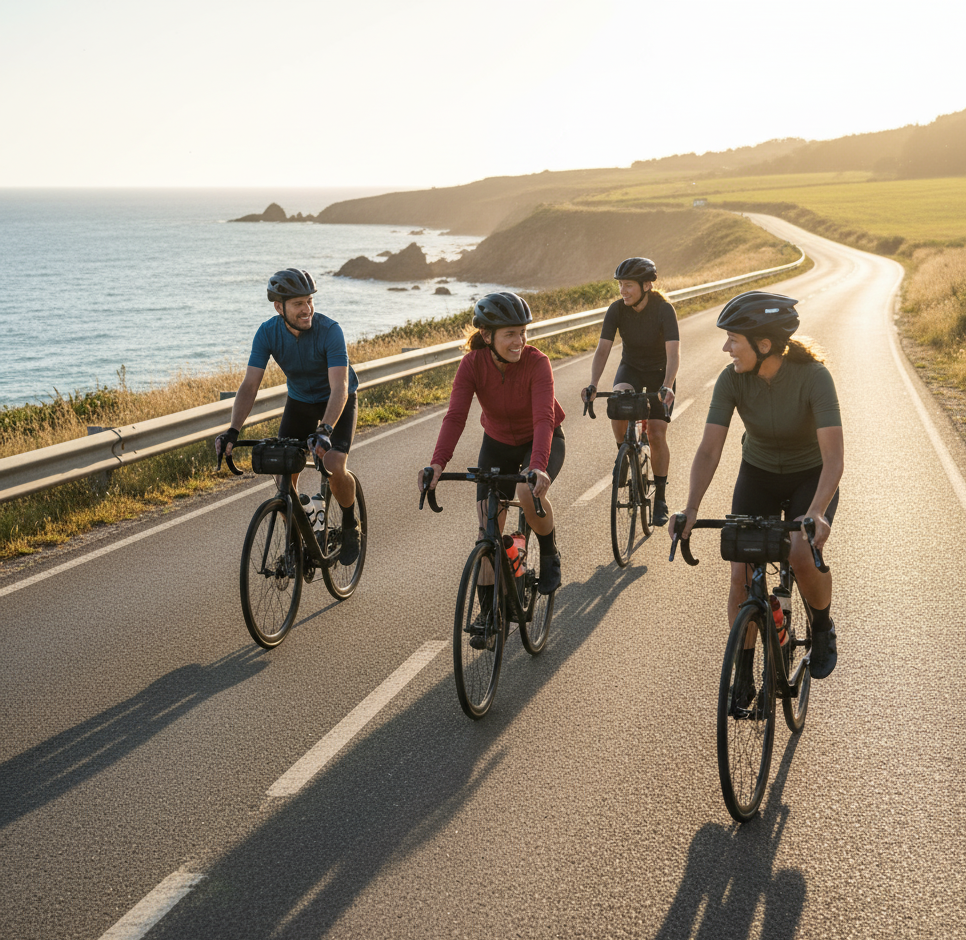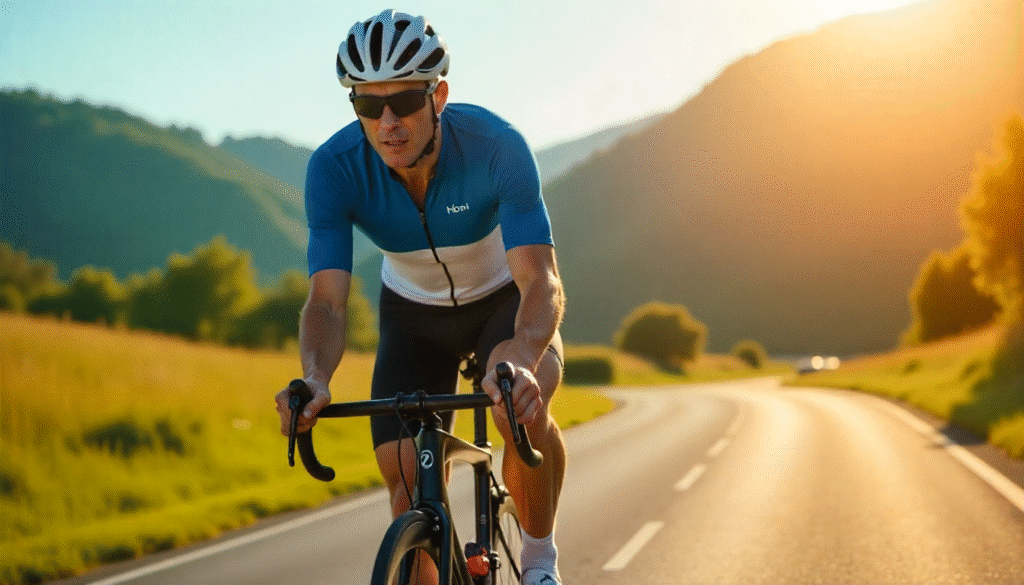The Best Fluffy Pancakes recipe you will fall in love with. Full of tips and tricks to help you make the best pancakes.
Road Cycling for Weight Loss: What Works?
Effective strategies combining training, nutrition, and tracking.
Picture this—and I mean really visualize it because this happened to my neighbor Steve just last month. You’ve been grinding away on your bike for what feels like forever (okay, maybe six months but who’s counting?), pushing yourself until your lungs feel like they’re on fire and your legs scream for mercy. Yet that damn scale… it just sits there. Mocking you. Laughing at your lycra-clad efforts, wondering if I was secretly cursed by the road cycling gods not letting me achieve weight loss.
I remember standing in my garage after a particularly brutal hill repeat session, sweat pooling on the concrete floor like some twisted Jackson Pollock painting. What if—and hear me out on this—what if the very intensity we wear like a badge of honor is actually sabotaging our fat-burning dreams?
Zone 2 Training: Road Cycling’s Best-Kept Weight Loss Secret

Zone 2 training is… well, think of it like this. You know how your grandmother’s old Buick could cruise on the highway for hours without breaking a sweat? That’s Zone 2—operating at 60-70% of your maximum heart rate, feeling so ridiculously easy that you’ll probably question whether you’re actually exercising at all.
But here’s the kicker (and this is where things get interesting): while you’re practically having a conversation with passing butterflies, your body is transforming into this incredible fat-burning machine. Your mitochondria—those tiny cellular powerhouses that high school biology class forgot to make exciting—are multiplying like rabbits in spring. They’re becoming more efficient at processing fat than a food processor tackles onions.
The last time I went for what felt like a Sunday stroll on wheels, I caught myself thinking, “Am I even doing this right?” That nagging voice in your head? The one that insists pain equals progress? It’s been lying to you this whole time. During Zone 2 efforts, your body learns to preferentially burn stored fat as fuel, creating this beautiful metabolic adaptation that keeps working even when you’re binge-watching Netflix later. (Though honestly, who has time for TV when there are bikes to ride?)
Why We All Got Hoodwinked by the Intensity Trap
The fitness industry—bless their profit-driven hearts—has basically brainwashed us into believing that suffering equals success. Every cycling magazine cover screams about high-intensity intervals. Social media feeds overflow with videos of people looking like they’re about to expire from effort, because apparently that’s what “real training” looks like now.
But here’s an uncomfortable truth that’ll make you want to throw your power meter out the window: when you’re redlining your effort, gasping like a fish out of water, your body switches gears faster than a NASCAR pit crew. It starts burning glycogen (those stored carbs) because fat—poor, misunderstood fat—simply can’t be processed quickly enough to meet your energy demands.
Ever notice how you could eat an entire pizza after a crushing workout? That’s not willpower failure; that’s biology. Your body is desperately trying to replenish those glycogen stores you just obliterated, often leading to what I call “the great overconsumption paradox.” You work your ass off to create a caloric deficit, then your primal brain takes over and you end up face-deep in a bag of chips.
Zone 2 training sidesteps this whole metabolic circus act.
Most of us also fall victim to the “more is better” philosophy—which, let’s be honest, works great for collecting vintage bike parts but terrible for fat loss. If a little intensity feels productive, surely more intensity must be exponentially better, right? Wrong. Dead wrong. This approach floods your system with stress hormones like cortisol, which has this delightful habit of promoting fat storage, particularly around your midsection. Life’s cruel joke: pushing harder often makes losing weight… well, harder.
Making This Magic Happen (Without Losing Your Mind)

Implementation is deceptively simple, though it requires rewiring your brain’s relationship with effort. First, figure out your Zone 2 heart rate range using the basic formula: (220 minus your age) times 0.6 for the lower boundary, times 0.7 for the upper limit. Or—if you’re feeling fancy and have money burning a hole in your cycling budget—get a lactate threshold test that’ll give you precision worthy of Swiss engineering.
During Zone 2 sessions, you should be able to chat. Not just grunt responses or breathe out single-syllable words, but actually discuss whether pineapple belongs on pizza or debate the merits of disc brakes versus rim brakes. (For the record: pineapple is acceptable, disc brakes are superior, fight me.) If you can’t string together complete sentences without gasping, you’re working too hard. This conversational pace becomes your new gold standard.
Start by swapping two weekly rides for pure Zone 2 sessions. Begin with 60-90 minutes—I know, it feels like forever when you’re used to 45-minute sufferfests—and gradually build toward 2-3 hours as your aerobic foundation strengthens. Yes, this means eating humble pie when faster riders blow past you on climbs. Let them go. You’re playing chess while they’re playing checkers.
The real magic happens through consistency rather than intensity. Can you stick with this approach for months instead of weeks? Zone 2 adaptations are profound but gradual—think geological time scales rather than Instagram transformation posts. Typically, you’ll need 6-12 weeks before noticing significant changes in how your clothes fit, and 3-6 months for complete metabolic renovation.
The Long Game That Changes Everything
What makes Zone 2 training absolutely revolutionary (and I don’t use that word lightly) isn’t just what happens during your rides. It’s how it transforms your entire metabolic operating system, 24/7. As mitochondrial density increases and your fat-oxidation capacity improves, you become more efficient at burning stored fat during mundane activities—walking the dog, doing dishes, even sleeping.
This metabolic flexibility thing—the ability to seamlessly switch between fuel sources like a hybrid car—is perhaps the most undervalued aspect of sustainable weight management. Unlike crash diets or extreme training regimens that slow your metabolic rate to a crawl, Zone 2 training actually enhances it. Creates this positive feedback loop that makes maintaining your ideal weight feel effortless rather than exhausting.
Think about it: would you rather spend years on the yo-yo diet roller coaster, cycling between brief periods of intense restriction and inevitable rebound weight gain? Or invest a few months building a metabolic engine that naturally maintains your target weight without constant white-knuckling?
The choice seems obvious when you frame it that way. Yet most cyclists choose the former through their training choices.
Time to Join the Underground Revolution

The cycling community is packed with weekend warriors pushing themselves to the brink of collapse, wondering why their weight loss efforts plateau despite their unwavering dedication. You now possess insider knowledge—the kind that separates the metabolically savvy from the merely exhausted.
But here’s the thing about knowledge: without action, it’s just expensive trivia.
Will you have the courage to slow down in order to speed up your results? Can you trust a process that feels almost too easy? Will you prioritize long-term metabolic health over short-term ego stroking and Strava segment hunting?
Your choice. But the clock’s ticking, and every high-intensity session you choose over Zone 2 training is another day you postpone unlocking your body’s natural fat-burning potential. Your future self—leaner, stronger, metabolically optimized—is waiting for you to make this pivotal decision.
Embrace the secret. Trust the science. Transform everything.
Check our Full Road Cycling Guide to learn more about the hidden tips.





